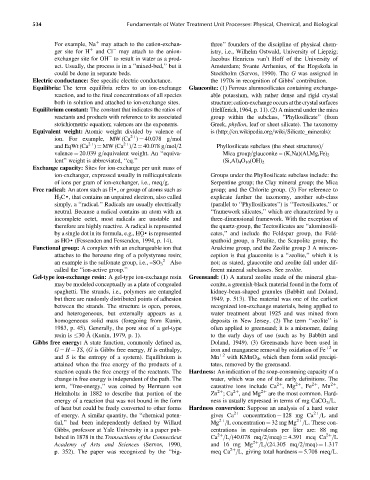Page 579 - Fundamentals of Water Treatment Unit Processes : Physical, Chemical, and Biological
P. 579
534 Fundamentals of Water Treatment Unit Processes: Physical, Chemical, and Biological
For example, Na may attach to the cation-exchan- three’’ founders of the discipline of physical chem-
þ
ger site for H þ and Cl may attach to the anion- istry, i.e., Wilhelm Ostwald, University of Liepzig;
exchanger site for OH to result in water as a prod- Jacobus Henricus van’t Hoff of the University of
uct. Usually, the process is in a ‘‘mixed-bed,’’ but it Amsterdam; Svante Arrhenius, of the Hogskola in
could be done in separate beds. Stockholm (Servos, 1990). The G was assigned in
Electric conductance: See specific electric conductance. the 1970s in recognition of Gibbs’ contribution.
Equilibria: The term equilibria refers to an ion-exchange Glauconite: (1) Ferrous alumnosilicates containing exchange-
reaction, and to the final concentrations of all species able potassium, with rather dense and rigid crystal
both in solution and attached to ion-exchange sites. structure;cation-exchangeoccursatthecrystalsurfaces
Equilibrium constant: The constant that indicates the ratios of (Helfferich, 1964, p. 11). (2) A mineral under the mica
reactants and products with reference to its associated group within the subclass, ‘‘Phyllosilicate’’ (from
stoichiometric equation; valences are the exponents. Greek, phyllon, leaf or sheet silicate). The taxonomy
Equivalent weight: Atomic weight divided by valence of is (http:==en.wikipedia.org=wiki=Silicate_minerals):
ion. For example, MW (Ca ) ¼ 40.078 g=mol
2þ
and EqWt (Ca ) ¼ MW (Ca )=2 ¼ 40.078 g=mol=2 Phyllosilicate subclass (the sheet structures)=
2þ
2þ
valence ¼ 20.039 g=equivalent weight. An ‘‘equiva- Mica group=glauconite – (K,Na)(Al,Mg,Fe) 2
lent’’ weight is abbreviated, ‘‘eq.’’ (Si,Al) 4 O 10 (OH) 2
Exchange capacity: Sites for ion-exchange per unit mass of
ion-exchanger, expressed usually in milliequivalents Groups under the Phyllosilicate subclass include: the
of ions per gram of ion-exchanger, i.e., meq=g. Serpentine group; the Clay mineral group; the Mica
Free radical: An atom such as H . , or group of atoms such as group; and the Chlorite group. (3) For reference to
H 3 C . , that contains an unpaired electron, also called explicate further the taxonomy, another sub-class
simply, a ‘‘radical.’’ Radicals are usually electrically (parallel to ‘‘Phyllosilicates’’)is ‘‘Tectosilicates,’’ or
neutral. Because a radical contains an atom with an ‘‘framework silicates,’’ which are characterized by a
incomplete octet, most radicals are unstable and three-dimensional framework. With the exception of
therefore are highly reactive. A radical is represented the quartz-group, the Tectosilicates are ‘‘aluminosili-
::
by a single dot in its formula, e.g., HO . is represented cates,’’ and include the Feldspar group, the Feld-
::
as HO . (Fessenden and Fessenden, 1994, p. 14). spathoid group, a Petalite, the Scapolite group, the
Functional group: A complex with an exchangeable ion that Analcime group, and the Zeolite group 3 A miscon-
attaches to the benzene ring of a polystyrene resin; ception is that glauconite is a ‘‘zeolite,’’ which it is
2 Also not; as stated, glauconite and zeolite fall under dif-
an example is the sulfonate group, i.e., –SO 3
called the ‘‘ion-active group.’’ ferent mineral subclasses. See zeolite.
Gel-type ion-exchange resin: A gel-type ion-exchange resin Greensand: (1) A natural zeolite made of the mineral glau-
may be modeled conceptually as a plate of congealed conite, a greenish-black material found in the form of
spaghetti. The strands, i.e., polymers are entangled kidney-bean-shaped granules (Babbitt and Doland,
but there are randomly distributed points of adhesion 1949, p. 513). The material was one of the earliest
between the strands. The structure is open, porous, recognized ion-exchange materials, being applied to
and heterogeneous, but externally appears as a water treatment about 1925 and was mined from
homogeneous solid mass (foregoing from Kunin, deposits in New Jersey. (2) The term ‘‘zeolite’’ is
1983, p. 45). Generally, the pore size of a gel-type often applied to greensand; it is a misnomer, dating
resin is 30 Å (Kunin, 1979, p. 1). to the early days of use (such as by Babbitt and
Gibbs free energy: A state function, commonly defined as, Doland, 1949). (3) Greensands have been used in
G ¼ H TS,(G is Gibbs free energy, H is enthalpy, iron and manganese removal by oxidation of Fe þ2 or
and S is the entropy of a system). Equilibrium is Mn þ2 with KMnO 4 , which then form solid precipi-
attained when the free energy of the products of a tates, removed by the greensand.
reaction equals the free energy of the reactants. The Hardness: An indication of the soap-consuming capacity of a
change in free energy is independent of the path. The water, which was one of the early definitions. The
term, ‘‘free-energy,’’ was coined by Hermann von causative ions include Ca ,Mg ,Fe ,Mn ,
2þ
2þ
2þ
2þ
Helmholtz in 1882 to describe that portion of the Zn ;Ca , and Mg 2þ are the most common. Hard-
2þ
2þ
energy of a reaction that was not bound in the form ness is usually expressed in terms of mg CaCO 3 =L.
of heat but could be freely converted to other forms Hardness conversion: Suppose an analysis of a hard water
of energy. A similar quantity, the ‘‘chemical poten- gives Ca 2þ concentration ¼ 128 mg Ca =L and
2þ
tial,’’ had been independently defined by Willard Mg =L concentration ¼ 32 mg Mg =L. These con-
2þ
2þ
Gibbs, professor at Yale University in a paper pub- centrations in equivalents per liter are: 88 mg
lished in 1878 in the Transactions of the Connecticut Ca =L=(40.078 mq=2=meq) ¼ 4.391 meq Ca =L
2þ
2þ
Academy of Arts and Sciences (Servos, 1990, and 16 mg Mg =L=(24.305 mq=2=meq) ¼ 1.317
2þ
p. 352). The paper was recognized by the ‘‘big- meq Ca =L, giving total hardness ¼ 5.708 meq=L.
2þ

